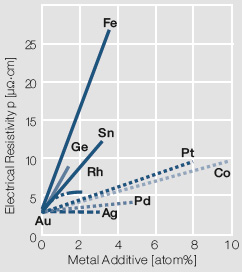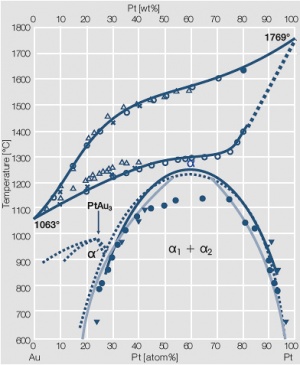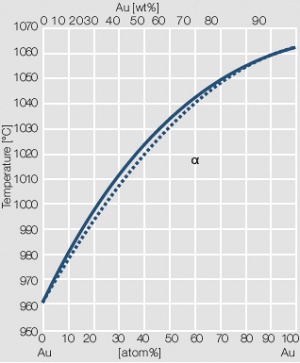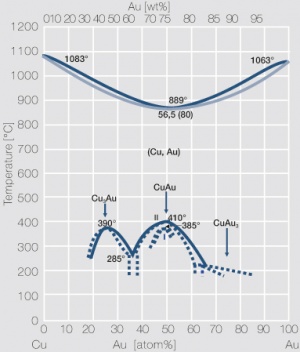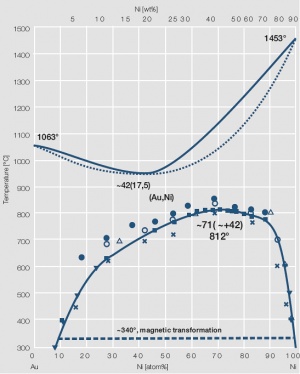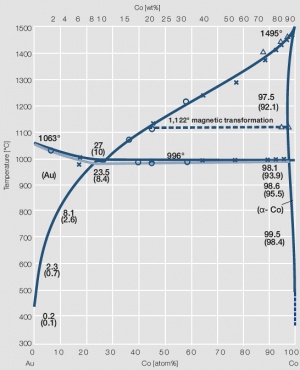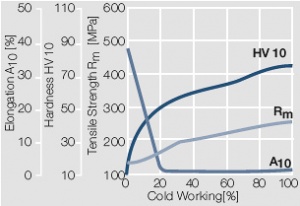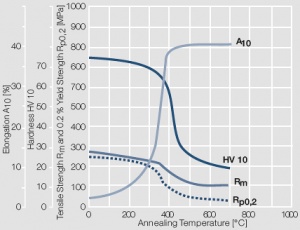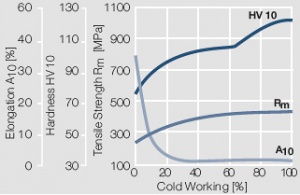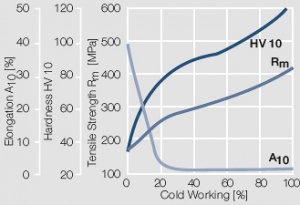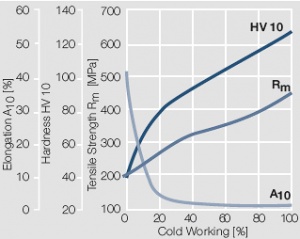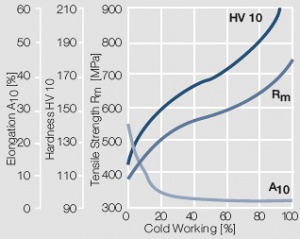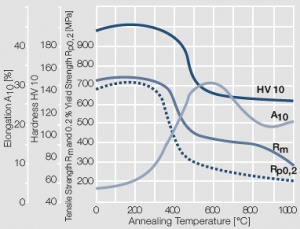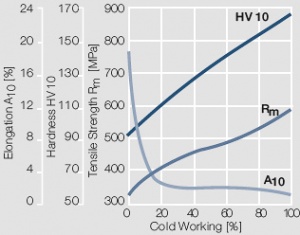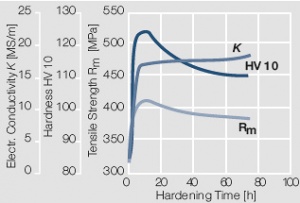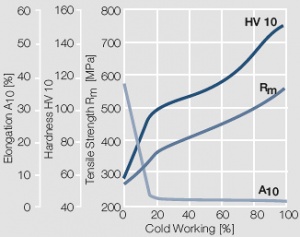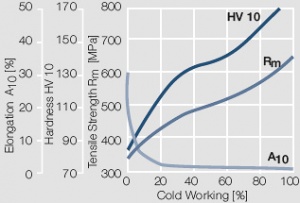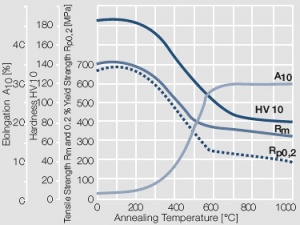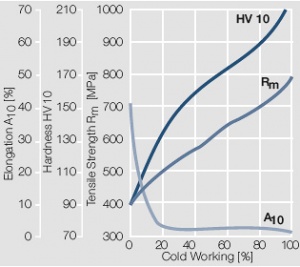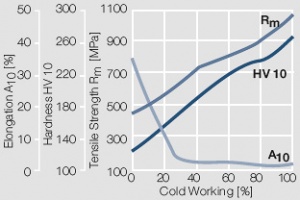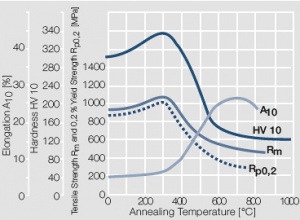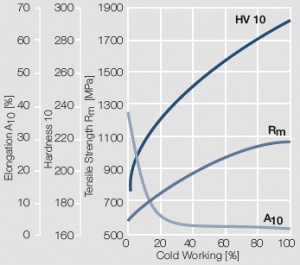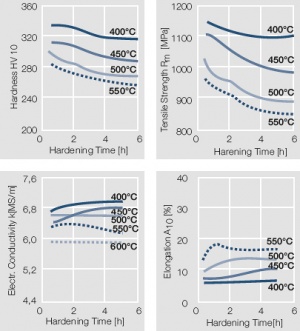Difference between revisions of "Werkstoffe auf Gold-Basis"
Teitscheid (talk | contribs) (temp edit) |
Teitscheid (talk | contribs) (German translation) |
||
| Line 170: | Line 170: | ||
| − | <xr id="fig:Phase diagram of goldplatinum"/> Fig. 2.3: | + | <xr id="fig:Phase diagram of goldplatinum"/> Fig. 2.3: Zustandsdiagramm von Gold-Platin |
| − | <xr id="fig:Phase diagram of gold-silver"/> Fig. 2.4: | + | <xr id="fig:Phase diagram of gold-silver"/> Fig. 2.4: Zustandsdiagramm von Gold-Silber |
| − | <xr id="fig:Phase diagram of gold-copper"/> Fig. 2.5: | + | <xr id="fig:Phase diagram of gold-copper"/> Fig. 2.5: Zustandsdiagramm von Gold-Kupfer |
| − | <xr id="fig:Phase diagram of gold-nickel"/> Fig. 2.6: | + | <xr id="fig:Phase diagram of gold-nickel"/> Fig. 2.6: Zustandsdiagramm von Gold-Nickel |
| − | <xr id="fig:Phase diagram of gold-cobalt"/> Fig. 2.7: | + | <xr id="fig:Phase diagram of gold-cobalt"/> Fig. 2.7: Zustandsdiagramm von Gold-Kobalt |
| − | <xr id="fig:Strain hardening of Au by cold working"/> Fig. 2.8: | + | <xr id="fig:Strain hardening of Au by cold working"/> Fig. 2.8: Verfestigungsverhalten von Au durch Kaltumformung |
| − | <xr id="fig:Softening of Au after annealing for 0.5 hrs"/> Fig. 2.9: | + | <xr id="fig:Softening of Au after annealing for 0.5 hrs"/> Fig. 2.9: Erweichungsverhalten von Au nach 0,5h Glühdauer und einer Kaltumformung von 80% |
| − | <xr id="fig:Strain hardening of AuPt10 by cold working"/> Fig. 2.10: | + | <xr id="fig:Strain hardening of AuPt10 by cold working"/> Fig. 2.10: Verfestigungsverhalten von AuPt10 durch Kaltumformung |
| − | <xr id="fig:Strain hardening of AuAg20 by cold working"/> Fig. 2.11: | + | <xr id="fig:Strain hardening of AuAg20 by cold working"/> Fig. 2.11: Verfestigungsverhalten von AuAg20 durch Kaltumformung |
| − | <xr id="fig:Strain hardening of AuAg30 by cold working"/> Fig. 2.12: | + | <xr id="fig:Strain hardening of AuAg30 by cold working"/> Fig. 2.12: Verfestigungsverhalten von AuAg30 durch Kaltumformung |
| − | <xr id="fig:Strain hardening of AuNi5 by cold working"/> Fig. 2.13: | + | <xr id="fig:Strain hardening of AuNi5 by cold working"/> Fig. 2.13: Verfestigungsverhalten von AuNi5 durch Kaltumformung |
| − | <xr id="fig:Softening of AuNi5 after annealing for 0.5 hrs"/> Fig. 2.14: | + | <xr id="fig:Softening of AuNi5 after annealing for 0.5 hrs"/> Fig. 2.14: Erweichungsverhalten von AuNi5 nach 0,5h Glühdauer und einer Kaltumformung von 80% |
| − | <xr id="fig:Strain hardening of AuCo5 by cold working"/> Fig. 2.15: | + | <xr id="fig:Strain hardening of AuCo5 by cold working"/> Fig. 2.15: Verfestigungsverhalten von AuCo5 durch Kaltumformung |
| − | <xr id="fig:Precipitation hardening of AuCo5 at"/> Fig. 2.16: | + | <xr id="fig:Precipitation hardening of AuCo5 at"/> Fig. 2.16: Aushärtung von AuCo5 bei 400°C Aushärtungstemperatur |
| − | <xr id="fig:Strain hardening of AuAg25Pt6 by cold working"/> Fig. 2.17: | + | <xr id="fig:Strain hardening of AuAg25Pt6 by cold working"/> Fig. 2.17: Verfestigungsverhalten von AuAg25Pt6 durch Kaltumformung |
| − | <xr id="fig:Strain hardening of AuAg26Ni3 by cold working"/> Fig. 2.18: | + | <xr id="fig:Strain hardening of AuAg26Ni3 by cold working"/> Fig. 2.18: Verfestigungsverhalten von AuAg26Ni3 durch Kaltumformung |
| − | <xr id="fig:Softening of AuAg26Ni3 after annealing for 0.5-hrs"/> Fig. 2.19: | + | <xr id="fig:Softening of AuAg26Ni3 after annealing for 0.5-hrs"/> Fig. 2.19: Erweichungsverhalten von AuAg26Ni3 nach 0,5h Glühdauer und einer Kaltumformung von 80% |
| − | <xr id="fig:Strain hardening of AuAg25Cu5 by cold working"/> Fig. 2.20: | + | <xr id="fig:Strain hardening of AuAg25Cu5 by cold working"/> Fig. 2.20: Verfestigungsverhalten von AuAg25Cu5 durch Kaltumformung |
| − | <xr id="fig:Strain hardening of AuAg20Cu10 by cold working"/> Fig. 2.21: | + | <xr id="fig:Strain hardening of AuAg20Cu10 by cold working"/> Fig. 2.21: Verfestigungsverhalten von AuAg20Cu10 durch Kaltumformung |
| − | <xr id="fig:Softening of AuAg20Cu10 after annealing for 0.5 hrs"/> Fig. 2.22: | + | <xr id="fig:Softening of AuAg20Cu10 after annealing for 0.5 hrs"/> Fig. 2.22: Erweichungsverhalten von AuAg20Cu10 nach 0,5h Glühdauer und einer Kaltumformung von 80% |
| − | <xr id="fig:Strain hardening of AuCu14Pt9Ag4 by cold working"/> Fig. 2.23: | + | <xr id="fig:Strain hardening of AuCu14Pt9Ag4 by cold working"/> Fig. 2.23: Verfestigungsverhalten von AuCu14Pt9Ag4 durch Kaltumformung |
| − | <xr id="fig:Precipitation hardening of AuCu14Pt9Ag4"/> Fig. 2.24: | + | <xr id="fig:Precipitation hardening of AuCu14Pt9Ag4"/> Fig. 2.24: Aushärtung von AuCu14Pt9Ag4 nach 50% Kaltumformung bei verschiedenen Anlasstemperaturen |
| Line 239: | Line 239: | ||
<div class="multiple-images"> | <div class="multiple-images"> | ||
<figure id="fig:Phase diagram of goldplatinum"> | <figure id="fig:Phase diagram of goldplatinum"> | ||
| − | [[File:Phase diagram of goldplatinum.jpg|left|thumb|<caption> | + | [[File:Phase diagram of goldplatinum.jpg|left|thumb|<caption>Zustandsdiagramm von Gold-Platin</caption>]] |
</figure> | </figure> | ||
<figure id="fig:Phase diagram of gold-silver"> | <figure id="fig:Phase diagram of gold-silver"> | ||
| − | [[File:Phase diagram of gold-silver.jpg|left|thumb|<caption> | + | [[File:Phase diagram of gold-silver.jpg|left|thumb|<caption>Zustandsdiagramm von Gold-Silber</caption>]] |
</figure> | </figure> | ||
<figure id="fig:Phase diagram of gold-copper"> | <figure id="fig:Phase diagram of gold-copper"> | ||
| − | [[File:Phase diagram of gold-copper.jpg|left|thumb|<caption> | + | [[File:Phase diagram of gold-copper.jpg|left|thumb|<caption>Zustandsdiagramm von Gold-Kupfer</caption>]] |
</figure> | </figure> | ||
<figure id="fig:Phase diagram of gold-nickel"> | <figure id="fig:Phase diagram of gold-nickel"> | ||
| − | [[File:Phase diagram of gold-nickel.jpg|left|thumb|<caption> | + | [[File:Phase diagram of gold-nickel.jpg|left|thumb|<caption>Zustandsdiagramm von Gold-Nickel</caption>]] |
</figure> | </figure> | ||
<figure id="fig:Phase diagram of gold-cobalt"> | <figure id="fig:Phase diagram of gold-cobalt"> | ||
| − | [[File:Phase diagram of gold-cobalt.jpg|left|thumb|<caption> | + | [[File:Phase diagram of gold-cobalt.jpg|left|thumb|<caption>Zustandsdiagramm von Gold-Kobalt</caption>]] |
</figure> | </figure> | ||
<figure id="fig:Strain hardening of Au by cold working"> | <figure id="fig:Strain hardening of Au by cold working"> | ||
| − | [[File:Strain hardening of Au by cold working.jpg|left|thumb|<caption> | + | [[File:Strain hardening of Au by cold working.jpg|left|thumb|<caption>Verfestigungsverhalten von Au durch Kaltumformung</caption>]] |
</figure> | </figure> | ||
<figure id="fig:Softening of Au after annealing for 0.5 hrs"> | <figure id="fig:Softening of Au after annealing for 0.5 hrs"> | ||
| − | [[File:Softening of Au after annealing for 0.5 hrs.jpg|left|thumb|<caption> | + | [[File:Softening of Au after annealing for 0.5 hrs.jpg|left|thumb|<caption>Erweichungsverhalten von Au nach 0,5h Glühdauer und einer Kaltumformung von 80%</caption>]] |
</figure> | </figure> | ||
<figure id="fig:Strain hardening of AuPt10 by cold working"> | <figure id="fig:Strain hardening of AuPt10 by cold working"> | ||
| − | [[File:Strain hardening of AuPt10 by cold working.jpg|left|thumb|<caption> | + | [[File:Strain hardening of AuPt10 by cold working.jpg|left|thumb|<caption>Verfestigungsverhalten von AuPt10 durch Kaltumformung</caption>]] |
</figure> | </figure> | ||
<figure id="fig:Strain hardening of AuAg20 by cold working"> | <figure id="fig:Strain hardening of AuAg20 by cold working"> | ||
| − | [[File:Strain hardening of AuAg20 by cold working.jpg|left|thumb|<caption> | + | [[File:Strain hardening of AuAg20 by cold working.jpg|left|thumb|<caption>Verfestigungsverhalten von AuAg20 durch Kaltumformung</caption>]] |
</figure> | </figure> | ||
<figure id="fig:Strain hardening of AuAg30 by cold working"> | <figure id="fig:Strain hardening of AuAg30 by cold working"> | ||
| − | [[File:Strain hardening of AuAg30 by cold working.jpg|left|thumb|<caption> | + | [[File:Strain hardening of AuAg30 by cold working.jpg|left|thumb|<caption>Verfestigungsverhalten von AuAg30 durch Kaltumformung</caption>]] |
</figure> | </figure> | ||
<figure id="fig:Strain hardening of AuNi5 by cold working"> | <figure id="fig:Strain hardening of AuNi5 by cold working"> | ||
| − | [[File:Strain hardening of AuNi5 by cold working.jpg|left|thumb|<caption> | + | [[File:Strain hardening of AuNi5 by cold working.jpg|left|thumb|<caption>Verfestigungsverhalten von AuNi5 durch Kaltumformung</caption>]] |
</figure> | </figure> | ||
<figure id="fig:Softening of AuNi5 after annealing for 0.5 hrs"> | <figure id="fig:Softening of AuNi5 after annealing for 0.5 hrs"> | ||
| − | [[File:Softening of AuNi5 after annealing for 0.5 hrs.jpg|left|thumb|<caption> | + | [[File:Softening of AuNi5 after annealing for 0.5 hrs.jpg|left|thumb|<caption>Erweichungsverhalten von AuNi5 nach 0,5h Glühdauer und einer Kaltumformung von 80%</caption>]] |
</figure> | </figure> | ||
<figure id="fig:Strain hardening of AuCo5 by cold working"> | <figure id="fig:Strain hardening of AuCo5 by cold working"> | ||
| − | [[File:Strain hardening of AuCo5 by cold working.jpg|left|thumb|<caption> | + | [[File:Strain hardening of AuCo5 by cold working.jpg|left|thumb|<caption>Verfestigungsverhalten von AuCo5 durch Kaltumformung</caption>]] |
</figure> | </figure> | ||
<figure id="fig:Precipitation hardening of AuCo5 at"> | <figure id="fig:Precipitation hardening of AuCo5 at"> | ||
| − | [[File:Precipitation hardening of AuCo5 at.jpg|left|thumb|<caption> | + | [[File:Precipitation hardening of AuCo5 at.jpg|left|thumb|<caption>Aushärtung von AuCo5 bei 400°C Aushärtungstemperatur</caption>]] |
</figure> | </figure> | ||
<figure id="fig:Strain hardening of AuAg25Pt6 by cold working"> | <figure id="fig:Strain hardening of AuAg25Pt6 by cold working"> | ||
| − | [[File:Strain hardening of AuAg25Pt6 by cold working.jpg|left|thumb|<caption> | + | [[File:Strain hardening of AuAg25Pt6 by cold working.jpg|left|thumb|<caption>Verfestigungsverhalten von AuAg25Pt6 durch Kaltumformung</caption>]] |
</figure> | </figure> | ||
<figure id="fig:Strain hardening of AuAg26Ni3 by cold working"> | <figure id="fig:Strain hardening of AuAg26Ni3 by cold working"> | ||
| − | [[File:Strain hardening of AuAg26Ni3 by cold working.jpg|left|thumb|<caption> | + | [[File:Strain hardening of AuAg26Ni3 by cold working.jpg|left|thumb|<caption>Verfestigungsverhalten von AuAg26Ni3 durch Kaltumformung</caption>]] |
</figure> | </figure> | ||
<figure id="fig:Softening of AuAg26Ni3 after annealing for 0.5-hrs"> | <figure id="fig:Softening of AuAg26Ni3 after annealing for 0.5-hrs"> | ||
| − | [[File:Softening of AuAg26Ni3 after annealing for 0.5-hrs.jpg|left|thumb|<caption> | + | [[File:Softening of AuAg26Ni3 after annealing for 0.5-hrs.jpg|left|thumb|<caption>Erweichungsverhalten von AuAg26Ni3 nach 0,5h Glühdauer und einer Kaltumformung von 80%</caption>]] |
</figure> | </figure> | ||
<figure id="fig:Strain hardening of AuAg25Cu5 by cold working"> | <figure id="fig:Strain hardening of AuAg25Cu5 by cold working"> | ||
| − | [[File:Strain hardening of AuAg25Cu5 by cold working.jpg|left|thumb|<caption> | + | [[File:Strain hardening of AuAg25Cu5 by cold working.jpg|left|thumb|<caption>Verfestigungsverhalten von AuAg25Cu5 durch Kaltumformung</caption>]] |
</figure> | </figure> | ||
<figure id="fig:Strain hardening of AuAg20Cu10 by cold working"> | <figure id="fig:Strain hardening of AuAg20Cu10 by cold working"> | ||
| − | [[File:Strain hardening of AuAg20Cu10 by cold working.jpg|left|thumb|<caption> | + | [[File:Strain hardening of AuAg20Cu10 by cold working.jpg|left|thumb|<caption>Verfestigungsverhalten von AuAg20Cu10 durch Kaltumformung</caption>]] |
</figure> | </figure> | ||
<figure id="fig:Softening of AuAg20Cu10 after annealing for 0.5 hrs"> | <figure id="fig:Softening of AuAg20Cu10 after annealing for 0.5 hrs"> | ||
| − | [[File:Softening of AuAg20Cu10 after annealing for 0.5 hrs.jpg|left|thumb|<caption> | + | [[File:Softening of AuAg20Cu10 after annealing for 0.5 hrs.jpg|left|thumb|<caption>Erweichungsverhalten von AuAg20Cu10 nach 0,5h Glühdauer und einer Kaltumformung von 80%</caption>]] |
</figure> | </figure> | ||
<figure id="fig:Strain hardening of AuCu14Pt9Ag4 by cold working"> | <figure id="fig:Strain hardening of AuCu14Pt9Ag4 by cold working"> | ||
| − | [[File:Strain hardening of AuCu14Pt9Ag4 by cold working.jpg|left|thumb|<caption> | + | [[File:Strain hardening of AuCu14Pt9Ag4 by cold working.jpg|left|thumb|<caption>Verfestigungsverhalten von AuCu14Pt9Ag4 durch Kaltumformung</caption>]] |
</figure> | </figure> | ||
<figure id="fig:Precipitation hardening of AuCu14Pt9Ag4"> | <figure id="fig:Precipitation hardening of AuCu14Pt9Ag4"> | ||
| − | [[File:Precipitation hardening of AuCu14Pt9Ag4.jpg|left|thumb|<caption> | + | [[File:Precipitation hardening of AuCu14Pt9Ag4.jpg|left|thumb|<caption>Aushärtung von AuCu14Pt9Ag4 nach 50% Kaltumformung bei verschiedenen Anlasstemperaturen</caption>]] |
</figure> | </figure> | ||
</div> | </div> | ||
Revision as of 15:32, 22 September 2014
Reines Gold ist neben Platin das chemisch beständigste aller Edelmetalle. Gold in unlegierter Form ist für die Verwendung als Kontaktwerkstoff in elektromechanischen Bauelementen aufgrund seiner Neigung zum Kleben und Kaltschweißen auch bei kleinen Kontaktkräften weniger gut geeignet. Außerdem ist Feingold nicht ausreichend mechanisch verschleißfest und widerstandsfähig bei elektrischer Belastung (Table 4). Daher beschränkt sich sein Einsatz meist auf dünne, galvanisch oder vakuumtechnisch aufgebrachte Schichten.
In der Praxis werden daher üblicherweise schmelztechnisch hergestellte Gold- Legierungen eingesetzt. Der Schmelzvorgang erfolgt dabei je nach Legierungskomponente in reduzierender Atmosphäre oder im Vakuum. Die Wahl der Legierungszusätze hängt wesentlich von der Anwendung der Werkstoffe ab. Aus der breiten Palette von Gold-Legierungen sind die binären Legierungen mit Zusätzen < 10 Massen-% an Edelmetallen wie Pt, Pd oder Ag bzw. Unedelmetallen wie Ni, Co, Cu hervorzuheben (Table 2). Diese Zusätze erhöhen einerseits die mechanische Festigkeit und wirken sich vorteilhaft auf das Schaltverhalten aus, verringern andererseits je nach Legierungspartner mehr oder weniger stark die elektrische Leitfähigkeit und die Korrosionsbeständigkeit (Figure 1).
Vor allem unter dem Aspekt der Goldeinsparung sind die ternären Legierungen mit Goldgehalten von ca. 70 Massen-% und Zusätzen von Ag und Cu bzw. Ag und Ni, z.B. AuAg25Cu5 oder AuAg20Cu10 zu sehen, die für viele Anwendungsfälle bei guten mechanischen Eigenschaften ausreichende Beständigkeit gegenüber Fremdschichtbildung bieten (Table 3).
Bezeichnung | Zusammensetzung Au (Mindestanteil) | Beimengungen in ppm/p> | Hinweise für die Verwendung |
|---|---|---|---|
Spektralreines Gold Gold | 99.999 | Cu < 3 Ag < 3 Ca < 1 Mg <1 Fe < 1 | Drähte, Bleche, Legierungszusätze für Halbleiter, elektronische Bauelemente |
Hochreines Gold | 99.995 | Cu < 10 Ag < 15 Ca < 20 Mg < 10 Fe < 3 Si < 10 Pb < 20 | Granalien für hochreine Legierungen, Bleche, Bänder, Rohre, Profile |
Barren-Gold | 99.95 | Cu < 100 Ag < 150 Ca < 50 Mg < 50 Fe < 30 Si < 10 | Legierungen, übliche Qualität |
| Werkstoff | Festigkeitszustand | Zugfestigkeit Rm [MPa] min. | Dehnung A10 [%] min. | Vickershärte HV |
|---|---|---|---|---|
| Au | R 140 R 170 R 200 R 240 |
140 170 200 240 |
30 3 2 1 |
20 50 60 70 |
| AuAg20 | R 190 R 250 R 320 R 390 |
190 250 320 390 |
25 2 1 1 |
38 70 95 115 |
| AuAg30 | R 220 R 260 R 320 R 380 |
220 260 320 380 |
25 3 1 1 |
45 75 95 110 |
| AuAg25Cu5 | R 400 R 470 R 570 R 700 |
400 470 570 700 |
25 4 2 2 |
90 120 160 185 |
| AuAg20Cu10 | R 480 R 560 R 720 R 820 |
480 560 720 820 |
20 3 1 1 |
125 145 190 230 |
| AuAg26Ni3 | R 350 R 420 R 500 R 570 |
350 420 500 570 |
20 2 1 1 |
85 110 135 155 |
| AuAg25Pt6 | R 280 R 330 R 410 R 480 |
280 330 410 480 |
18 2 1 1 |
60 90 105 125 |
| AuCo5 | R 340 R 390 R 450 R 530 |
340 390 450 530 |
10 2 1 1 |
95 105 120 150 |
| AuCo5 vergütet | heterogen | 360 | 3 | 110-130 |
| AuNi5 | R 380 R 450 R 560 R 640 |
380 450 560 640 |
25 3 2 1 |
115 135 160 190 |
| AuPt10 | R 260 R 310 R 370 R 410 |
260 310 370 410 |
20 2 1 1 |
80 90 100 105 |
| AuCu14Pt9Ag4 | R 620 R 700 R 850 R 950 vergütet |
620 700 850 950 900 |
20 3 2 1 3 |
190 225 260 270 280 |
Weitere ternäre Legierungen, die aus dem AuAg-System hervorgehen, sind die Werkstoffe AuAg26Ni3 und AuAg25Pt6. Diese Legierungen ähneln in ihren mechanischen Eigenschaften den AuAgCu-Legierungen, sind aber bei höheren Temperaturen deutlich oxidationsbeständiger (Table 4).
Werkstoff | Eigenschaften | ||
|---|---|---|---|
Au | Höchste Korrosionsbeständigkeit, geringe Härte | hohe elektrische Leitfähigkeit, starke Neigung zum Kaltschweißen | |
AuAg8 | Hohe Korrosionsbeständigkeit, thermokraftarm | niedriger Kontaktwiderstand | |
AuPt10 AuPd5 | Sehr hohe Korrosionsbeständigkeit | hohe Härte | |
AuAg10 - 30 | Weitgehend korrosionsbeständig | höhere Härte | |
AuNi5 AuCo5 | Hohe Korrosionsbeständigkeit, geringe Neigung zur Materialwanderung | hohe Härte | |
AuAg25Pt6 | Hohe Korrosionsbeständigkeit, niedriger Kontaktwiderstand | hohe Härte | |
AuAg26Ni3 AuAg25Cu5 AuAg20Cu10 | Bedingt korrosionsbeständig | hohe Härte | |
AuPd40 AuPd35Ag10 AuCu14Pt9Ag4 | Hohe Korrosionsbeständigkeit | hohe Verschleißfestigkeit | |
Aufgrund des hohen Goldpreises tendiert seit Jahren die Entwicklung zu Goldlegierungen mit weiter reduziertem Goldgehalt. Ausgangspunkt hierfür ist das System AuPd, für das eine durchgehende Mischbarkeit der Komponenten besteht. Neben binären Legierungen z.B. AuPd40 und ternären Legierungen AuPd35Ag9 wurden auch Vielstofflegierungen entwickelt. Diese Legierungen enthalten meist weniger als 50 Massen-% Au und sind häufig aushärtbar, so dass Härte und Festigkeit noch deutlich gesteigert werden können. Derartige Werkstoffe kommen vor allem in Gleitkontaktsystemen zum Einsatz.
Gold-Legierungen werden in Form von geschweißten Draht- und Profilabschnitten, Kontaktnieten und plattierten Stanzteilen eingesetzt. Je nach konstruktiver Gestaltung der Kontaktteile ist für die Wahl des Verbindungsverfahrens die Wirtschaftlichkeit des Fügeprozesses und vor allem der sparsame Einsatz des teuren Edelmetalles entscheidend.
Gold-Legierungen werden sowohl als schaltende Kontakte in Relais und Tasten, als auch in Steckverbindern sowie in verschiedenen Gleitkontaktsystemen, wie Potentiometer, Sensoren, Schleifringübertragung und DC-Kleinstmotoren eingesetzt (Table 5).
Werkstoff | Anwendungsbeispiele | Anwendungsformen |
|---|---|---|
Feingold (galvanisch) | Korrosionsschutz für Kontaktteile, ruhende Kontakte, Bondverbindungen | Galvanische Überzüge, Bondschichten |
Hartgold (galvanisch) | Kontaktteile für Steckverbinder und Schalter, Gleitkontaktbahnen, Bondverbindungen | Galvanische Überzüge auf Kontaktnieten und Stanzteilen |
Hartgold (gesputtert) | Kontaktstellen in Schaltern und Relais für geringe Lasten, Signalrelais | Kontaktschicht auf Miniprofilen |
AuAg8 | Schaltende Kontakte in trockenen Stromkreisen, Signalrelais | Kontaktniete, geschweißte Kontaktteile |
AuAg20 | Schaltende Kontakte für geringe Lasten, Signalrelais | Kontaktniete, geschweißte Kontaktteile |
AuAg25Cu5 AuAg25Cu10 AuAg26Ni3 | Kontaktteile für Steckverbinder, Schalter und Relais | Plattierungen auf Cu-Legierungen, Kontaktniete, Kontaktschicht auf Miniprofilen |
AuNi5 AuCo5 (heterogen) | Kontaktstellen in Schaltern und Relais für geringe und mittlere Lasten, materialwanderungsbeständige Kontakte | Kontaktniete, geschweißte Kontakte, Kontaktschicht auf Miniprofilen |
AuPt10 AuAg25Pt6 | Kontakte höchster chemischer Beständigkeit in Schaltern und Relais | Kontaktniete, Kontaktschicht auf Miniprofilen |
AuCu14Pt9Ag4 | Gleitkontakte für Messwertübertrager | Drahtbiegeteile |
Figure 2 Fig. 2.3: Zustandsdiagramm von Gold-Platin
Figure 3 Fig. 2.4: Zustandsdiagramm von Gold-Silber
Figure 4 Fig. 2.5: Zustandsdiagramm von Gold-Kupfer
Figure 5 Fig. 2.6: Zustandsdiagramm von Gold-Nickel
Figure 6 Fig. 2.7: Zustandsdiagramm von Gold-Kobalt
Figure 7 Fig. 2.8: Verfestigungsverhalten von Au durch Kaltumformung
Figure 8 Fig. 2.9: Erweichungsverhalten von Au nach 0,5h Glühdauer und einer Kaltumformung von 80%
Figure 9 Fig. 2.10: Verfestigungsverhalten von AuPt10 durch Kaltumformung
Figure 10 Fig. 2.11: Verfestigungsverhalten von AuAg20 durch Kaltumformung
Figure 11 Fig. 2.12: Verfestigungsverhalten von AuAg30 durch Kaltumformung
Figure 12 Fig. 2.13: Verfestigungsverhalten von AuNi5 durch Kaltumformung
Figure 13 Fig. 2.14: Erweichungsverhalten von AuNi5 nach 0,5h Glühdauer und einer Kaltumformung von 80%
Figure 14 Fig. 2.15: Verfestigungsverhalten von AuCo5 durch Kaltumformung
Figure 15 Fig. 2.16: Aushärtung von AuCo5 bei 400°C Aushärtungstemperatur
Figure 16 Fig. 2.17: Verfestigungsverhalten von AuAg25Pt6 durch Kaltumformung
Figure 17 Fig. 2.18: Verfestigungsverhalten von AuAg26Ni3 durch Kaltumformung
Figure 18 Fig. 2.19: Erweichungsverhalten von AuAg26Ni3 nach 0,5h Glühdauer und einer Kaltumformung von 80%
Figure 19 Fig. 2.20: Verfestigungsverhalten von AuAg25Cu5 durch Kaltumformung
Figure 20 Fig. 2.21: Verfestigungsverhalten von AuAg20Cu10 durch Kaltumformung
Figure 21 Fig. 2.22: Erweichungsverhalten von AuAg20Cu10 nach 0,5h Glühdauer und einer Kaltumformung von 80%
Figure 22 Fig. 2.23: Verfestigungsverhalten von AuCu14Pt9Ag4 durch Kaltumformung
Figure 23 Fig. 2.24: Aushärtung von AuCu14Pt9Ag4 nach 50% Kaltumformung bei verschiedenen Anlasstemperaturen

